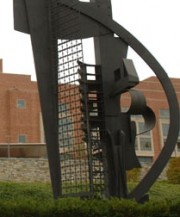(1899-1988) was a prominent sculptor, painter, and printmaker, born on September 23, 1899, in Pereyaslav, Russia. At the age of five, she came to Rockland with her mother, older brother, and younger sister to join her father, Isaac Berliawsky, who had immigrated a few years earlier. Although she took the commercial course at Rockland High School and graduated in 1918, she showed a talent for art and her art teachers encouraged her.
Louise met a wealthy New Yorker who was visiting Rockland. He introduced her to his brother, Charles S. Nevelson; they married in June 1920 and had a son in 1922. After a dissatisfying marriage, they divorced in 1941.
In the early 1920’s, she took courses in voice, acting, and art. In 1929 Nevelson was accepted to the Art Students League in New York City to study with Kenneth Hayes Miller and other artists.
In 1931 after sending her son to stay with relatives in Maine, she traveled to Europe to study with Hans Hofmann, a German teacher of modern art. Unhappy studying with Hofmann, she went to Italy and Paris where an exhibit of African carvings inspired her. Returning to New York a year later, Nevelson again studied art at the Art Students League with George Grosz.
During the 1930’s Nevelson started to create cubist semi-abstract sculptures. She studied with Chaim Gross, then attended the Sculpture Center, and studied modern dance. She had a countless number of friends, including Mexican artist, Diego Rivera, who inspired her interest in pre-Columbian sculpture.
To support herself and child, she taught art through the Works Progress Administration and painted portraits and exhibited her drawings, paintings, and sculptures in group shows. Art dealer Karl Nierendorf sponsored her first one-artist show at his New York Gallery.
In 1945 her relatives from Maine bought her a brownstone in New York City as a place for her to store and showcase her art. When Nierendorf died in 1947, she was left without a dealer. Her art was then ignored. She was also banned from an exhibit at the Museum of Modern Art in 1951, partly because she was a woman and would not discuss art intellectually. Her response was to join the National Association of Women Artists and work with them on group shows.
It was in the 1950s that Nevelson developed the style for which she is most famous. She picked up street garbage and debris, painted it, and put it in huge wall boxes. Colette Roberts, New York art critic and former director of the Grand Central Moderns Gallery, exhibited these pieces.
Nevelson won recognition in 1956 when the Whitney Museum bought her sculpture, Black Majesty. It was followed by sales to the Brooklyn Museum of Art and the Museum of Modern Art. In 1964 Arnold Glimcher’s show of her work at his Pace gallery in New York was such a success that he continued to exhibit her work for the rest of her life. A major retrospective at the Whitney Museum followed and commissions to create an outdoor steel sculpture at Princeton University and a collection of outdoor steel sculptures for the Louise Nevelson Plaza in lower Manhattan.
Louise Nevelson was elected to the American Academy of Arts and Letters at the age of eighty. She died of lung cancer on April 17, 1988 in Manhattan, at eighty-eight.
Additional resources
Adlmann, Jan Ernst. Louise Nevelson: A Loan Exhibition, William A. Farnsworth Library and Art Museum, Rockland, Maine, Norton Gallery and School of Art, West Palm Beach Florida, Jacksonville Art Museum, Jacksonville, Florida, Scottsdale Center for the Arts, Scottsdale, Arizona. Organized by the William A. Farnsworth Library and Art Museum, 1979. Rockland. William A. Farnsworth Library and Art Museum. 1979.
Cain, Michael. Louise Nevelson. New York. Chelsea House. c1989.
Collections Online: Louise Nevelson. Smithsonian Archives of American Art. http://www.aaa.si.edu/collectionsonline/neveloui/
Gordon, John. Louise Nevelson. New York. Published for the Whitney Museum of American Art, by Frederick A. Praeger. 1967.
Lipman, Jean. Nevelson’s World. New York. Hudson Hills Press in association with the Whitney Museum of American Art. Distributed in the U.S. by Viking Penguin. c1983.
Lisle, Laurie. Louise Nevelson: A Passionate Life. New York. Washington Square Press. c1990.
Lisle, Laurie. “Louise Nevelson” in Notable American Women, Completing the Twentieth Century. Cambridge: Harvard University Press, 2004, pp. 467-468.
“Nevelson work now officially a part of NIH.” Clinical Center News. http://www.cc.nih.gov/about/news/newsletter/2006/nov06/newsletter.html (accessed June 3, 2008)
Rapaport, Brooke Kamin. (ed.) The Sculpture of Louise Nevelson: Constructing a Legend. New York. Under the auspices of the Jewish Theological Seminary of America; New Haven. Yale University Press. c2007.
Contributed by Shannon Landry, Topsham, Maine, 2008.



